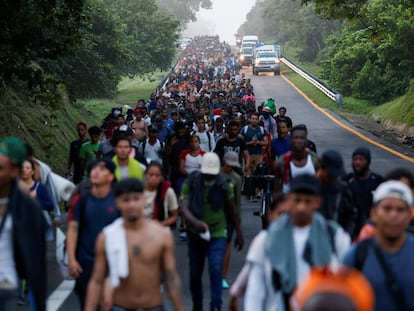Two guns pointed at a child’s head: More migrants and more violence along Mexico’s southern border, due to the ‘Trump effect’
Since the Republican magnate’s victory in the United States, between 800 and 1,200 migrants have been crossing the river from Guatemala every day, while stalked by organized crime. This is more than double the figure recorded on previous dates
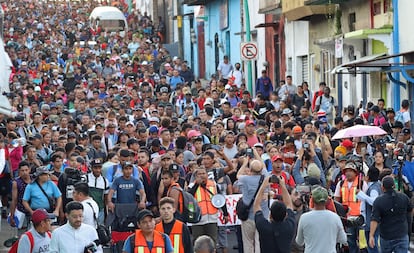
As the raft touched the riverbank, a gun was placed against Efraím’s head. The man holding it ordered everyone to get off. He walked them to a nearby house, where he demanded $500 in exchange for not killing them all. Efraím is a four-year-old girl from Luanda, the capital of Angola. After crossing half the world, that morning, she had finally arrived in Mexico.
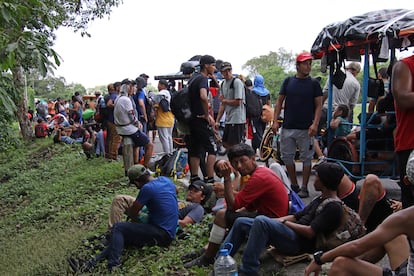
“They took every last thing we had: a phone, money, even our clothes,” says Alfonso, Efraím’s father. The 48-year-old man picked up a little Spanish during his short stay in São Paulo, Brazil’s financial capital, so he can communicate with EL PAÍS. This family of seven — Efraím, Alfonso, his pregnant wife and four more of their children — fled their homeland five months ago because of the armed conflicts that ravage it. “I’ve never been shot, but the poverty is terrible. I can’t pay for food, healthcare, or education for my daughter. That’s also war,” he explains.
The man with the gun held the family captive for about four hours until he took everything they were carrying. Then, he let them go. But just a short while earlier, on the other side of the Suchiate River, on the Guatemalan side of Mexico’s southern border, another gun was pointed at little Efraím’s head. “Terrible,” Alfonso laments. “There, they took another $200 and my watch,” he recalls.
This wouldn’t be the first time that a robber decided to threaten the youngest of the group. While they were crossing the Darién Jungle — the perilous crossing between Colombia and Panama — another person pointed a gun at her, again to steal money from her family.
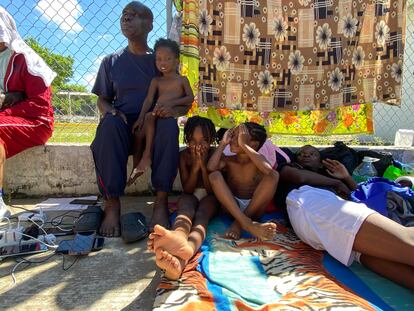
Mexico’s southern border is experiencing a massive surge of migrants trying to reach the United States. They’re coming from all over the world, in a race against time before president-elect Donald Trump takes office on January 20. Trump has promised to close the border and carry out mass deportations. That’s why there’s now a stampede. And, in the face of the massive arrival of migrants, organized crime has surged.
According to local activists, since November 6, when Trump’s victory was confirmed, between 800 and 1,200 migrants have crossed the river every day. In previous months, according to the same counts, the daily flow was around 300 migrants. Activists have referred to this increase as “the Trump effect.” The president-elect came to power by promising to criminalize migration.
Faced with this scenario, thousands of migrants have gathered in the city of Tapachula, on the border between Mexico and Guatemala. They’ve set out in caravans, as a way of protecting themselves from the mass kidnappings that are carried out every day by organized criminal groups in this region. Local activists consulted for this article — as well as a human trafficker, who asked to remain anonymous — say that each migrant has to pay about 40,000 Mexican pesos (the equivalent of $2,000) to the mafias, in order to guarantee their passage through Mexico. This money is either handed over to pay for transportation, or to appease extortionists at different points along the way.
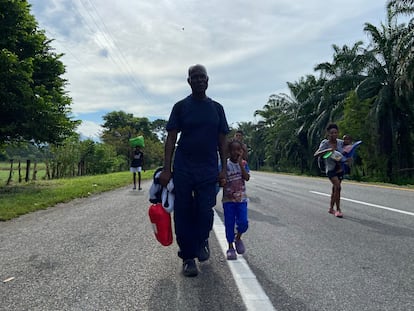
Kidnappings by organized crime are so widespread on Mexico’s southern border that they seem like an industry. Some migrants have reported that, after paying the ransom and being released, their captors put a stamp on their skin, or a bracelet of a certain color, which guarantees that they won’t be kidnapped again. Or, at least, for a little while.
One morning, at the end of October, Efraím walks hand-in-hand with her father, on pavement that burns the soles of her feet. Alfonso limps on his left leg. He explains that, years ago, he suffered an injury. He also notes how, along the way, they ran out of money to pay a “coyote” — a human trafficker — and their only option is to travel in a group on foot. This family has crossed the world and nine borders before reaching the United States: Angola, Brazil, Ecuador, Colombia, Panama, Costa Rica, Nicaragua, Honduras, Guatemala, and now Mexico. “I don’t want any more kidnappings,” Alfonso sighs.
That same morning the caravan, made up of some 2,000 migrants of different nationalities, was advancing from Huixtla, a town in the Mexican state of Chiapas. On their third day on the road, many of the people already looked exhausted. Following them, at least two more caravans, made up of almost the same number of undocumented immigrants, left Tapachula.
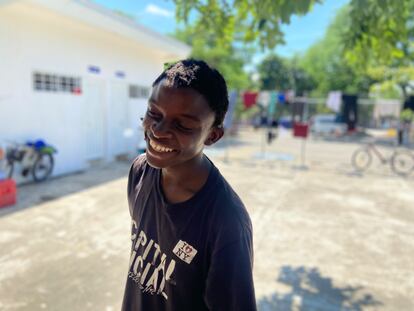
The southern region of Chiapas is disputed by three mafias: the Sinaloa Cartel, the Jalisco New Generation Cartel (CJNG) and the Chiapas-Guatemala Cartel. The war between cartels began around 2021, when the CJNG entered the territorial battle. More recently, the third group has joined the conflict. The fight for control involves not only the disputed drug route, but also the route traveled by hundreds of thousands of migrants, whom the narcos see as mere merchandise. A recent report by the Mexican Commission for Refugee Aid (COMAR) reveals that, in 2023, some 600,000 migrants from 165 countries passed through Tapachula.
The southern border of Mexico is the gateway to the final stretch of global migration, at least for those seeking to reach the United States. And right now, it’s undergoing very violent changes. The following incidents have occurred in the last year alone:
One morning, in the middle of this year, a group of about 100 migrants was walking along the route between Ciudad Hidalgo and Tapachula. Some of them told EL PAÍS that a group of men forced five people from the group to get into a pickup truck and kidnapped them. Days later, EL PAÍS observed a similar truck, filled with Black men. The vehicle didn’t have license plates, but it did have a sticker with the word “SINALOA.” According to a former municipal police officer — who spoke anonymously — these trucks are used by the cartel to transport kidnapped people.
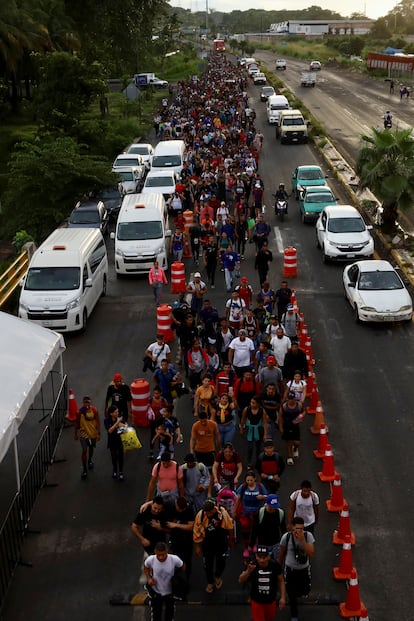
In early October of this year, a truck similar to the aforementioned one was traveling a couple of towns ahead of Tapachula, when it was intercepted by members of the Mexican army. The soldiers claimed to have been attacked and, after reacting to the gunfire, they killed six migrants and injured at least 12 more, who were locked up in the truck.
While many migrants are released after paying extortion fees, others are less fortunate. On Tuesday, November 19, in a rural area of Tapachula, two Cuban women were found dismembered inside some barrels. Local media outlets reported that, a day earlier, a video had circulated where one of the victims appeared: she was asking her family to pay the ransom. In the same area, a 16-year-old boy was killed — apparently, he was passing by on a motorcycle when the perpetrators were dumping the bodies. They killed him for having witnessed the crime.
The border state of Chiapas is in a stage of siege. In April, one of the three warring cartels claimed responsibility for the murder of 25 armed Guatemalan men, who were traveling in a truck. In July, thousands of people fled the Mexican town of Cuilco to the neighboring country — Guatemala — after two mafias took over. And, in October, in a horrifying scene, the mayor of Chilpancingo was found in his vehicle, after being beheaded by members of a local cartel.
After more than nine hours on the road, Efraím and her family arrive in Escuintla. There, they rest beside a soccer field. Gode, her mother, says that the long walk has made her dizzy. But she doesn’t plan on stopping. “I can die, but my children have to fulfill their dreams,” she says in Portuguese, which is translated with the help of her husband. Efraím plays with her older sister, Johana. Both smile for EL PAÍS while their photo is taken: for a moment, they seem to forget their odyssey.
Kaleb, their 16-year-old brother, says that his dream is to get to New York, where all his friends are. He wears a black shirt that says “I Love New York.” As she listens to her brother, Efraím says her dream out loud: “I want to be a firefighter.”
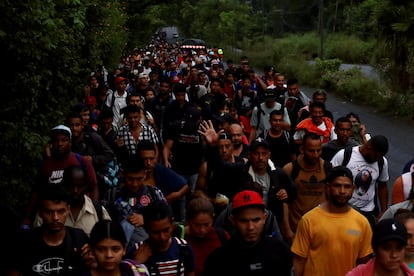
While it’s still the best option for the poorest migrants, caravans are no longer safe. According to some local activists and undocumented immigrants, organized crime has found ways to attack them. In mid-November, a second caravan broke up near the border between Chiapas and Oaxaca, the next state along the route. Organizers said they made the decision to split up, because “there were too many infiltrators.”
At least Efraím’s family made it. Last Friday afternoon, Gode sent a message to EL PAÍS with the good news: “We’re already in. We’re in Washington,” she said. They entered the country in the nick of time, before the migrants’ greatest fear — Trump — assumes power. They made it. But as for the hundreds of thousands of people trailing behind them, nobody knows what their fate will be.
Translated by Avik Jain Chatlani.
Sign up for our weekly newsletter to get more English-language news coverage from EL PAÍS USA Edition
Tu suscripción se está usando en otro dispositivo
¿Quieres añadir otro usuario a tu suscripción?
Si continúas leyendo en este dispositivo, no se podrá leer en el otro.
FlechaTu suscripción se está usando en otro dispositivo y solo puedes acceder a EL PAÍS desde un dispositivo a la vez.
Si quieres compartir tu cuenta, cambia tu suscripción a la modalidad Premium, así podrás añadir otro usuario. Cada uno accederá con su propia cuenta de email, lo que os permitirá personalizar vuestra experiencia en EL PAÍS.
¿Tienes una suscripción de empresa? Accede aquí para contratar más cuentas.
En el caso de no saber quién está usando tu cuenta, te recomendamos cambiar tu contraseña aquí.
Si decides continuar compartiendo tu cuenta, este mensaje se mostrará en tu dispositivo y en el de la otra persona que está usando tu cuenta de forma indefinida, afectando a tu experiencia de lectura. Puedes consultar aquí los términos y condiciones de la suscripción digital.
More information
Archived In
Últimas noticias
Most viewed
- Sinaloa Cartel war is taking its toll on Los Chapitos
- Oona Chaplin: ‘I told James Cameron that I was living in a treehouse and starting a permaculture project with a friend’
- Reinhard Genzel, Nobel laureate in physics: ‘One-minute videos will never give you the truth’
- Why the price of coffee has skyrocketed: from Brazilian plantations to specialty coffee houses
- Silver prices are going crazy: This is what’s fueling the rally

